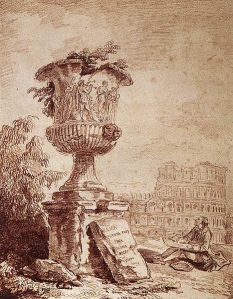I was at the Borghese Gallery with some delightful clients from North Carolina a couple of weeks ago, and the “Museum of the Universe” was looking particularly splendid. I’m usually a little perplexed by the annual exhibition staged at the Borghese; there’s already so much to look at in the collection that the overwhelming aesthetic sense can be that of witnessing the world’s grandest jumble sale, to the detriment of both the permanent and the temporary pieces. I’ve often wondered why the shows aren’t staged in the nearby aviary, leaving the main collection to sing uncluttered. This year’s show is, however, spectacularly different. It actually makes sense within the context of the gallery. That’s because the exhibition, “The Borghese and the Antique”, shows sixty pieces on loan from the Louvre in Paris, all of which have very good reason to be shown in these rooms; in some cases pieces which were placed here as soon as the gallery was built in the early seventeenth century. They form part of the Borghese collection in the Louvre, a total of nearly 700 pieces bought by Napoleon from his brother-in-law, Camillo Borghese in 1807.
One piece in particular, the Borghese Vase in the central entrance hall for the duration of the exhibition, has such a fierce connection with this part of Rome that I wondered in a moment of whimsy if it might resist being taken back to Paris at the end of the exhibition in April.
More accurately termed a krater, a vast wine receptable, it was carved from the glittering white marble of Mount Pentelikon in Attica, near Athens, shortly after the middle of the first century BC. After Greece fell under Roman control, the celebrated sculpture workshops of Attica began working for the Roman market. The vase is believed to be the product of one of these neo-Attic workshops. Its dating and attribution are partially on stylistic grounds and partially because two versions of the vase were found in the wreck of a ship which had been bound for Rome soon after the reign of Sulla, a reminder that the arduous voyages made by works of art were not always happy.
Befitting its function, almost unbearably exquisite reliefs detailing a Dionysian procession make their way around the vase. Figures dance to the tunes played by a piper, as the drunk Silenus is supported with difficulty by a satyr. The surface under the lip of the vase is carved with delicately interwoven vine leaves echoing the Dionysian theme.
The vase was discovered in the mid-sixteenth century an energetic stone’s throw from the Galleria Borghese. For what had become the place of the suburban pleasure villa of the Borghese family had been, one and a half millenia earlier, the vast pleasure gardens of Sallust, historian, politician, and ally of Julius Caesar. Sallust had returned from his lucrative stint as governor of Numidia (Tunisia/Algeria) and purchased a vast stretch of land between the Pincio and the Quirinal. Here he cultivated opulent gardens which would eventually become imperial property. He decorated them with the finest sculptures to be found, including this splendid krater.
After the fall of Empire the krater, like so much else, languished in the mud through centuries of struggle and violence, only to come to light as the ancient world was gathering currency, digging was worthwhile, and the aristocrats of the Renaissance were beginning to collect ancient statuary. In the early seventeenth century Scipione Borghese, cardinal nephew of Pope Paul V, echoed Sallust by developing his own pleasure garden on the Pincio beyond the edge of the city. It was only fitting that in 2012 the splendid Borghese vase should once again be admired here, in very the place for which it had left Athens.

The vase was a favourite with the Grand Tourists. Capriccio: draughtsman sketching the Borghese Vase. Hubert Robert c.1775
The Borghese and the Antique, until 9th April 2012.
I offer a “Borghese Gallery” itinerary focussing on the permanent collection
Galleria Borghese, Piazzale del Museo Borghese.
Tues-Sun 9am -7pm. 11 euros. Reservations required.


What an unbelievable journey!